Resources
 Part of the Oxford Instruments Group
Part of the Oxford Instruments Group
Expand
Collapse
 Part of the Oxford Instruments Group
Part of the Oxford Instruments Group
Qualitative Analysis - In digital imaging, the process of evaluating the appearance of an acquired image.
Quantitative Analysis - In digital imaging, the process of measuring and comparing the intensity of light incident on individual pixels.
Quantum Efficiency (QE) - The measure of the effectiveness of an imager to produce electronic charge from incident photons. Especially important to perform low-light-level imaging.
Radiometry - The science of measuring electromagnetic radiation, often accomplished with a device called a radiometer.
RAMAN - Radiation effect used in spectroscopy named after Sir Chandrasekhara Venkata Raman. It is used in condensed matter physics and chemistry to study vibrational, rotational, and other low-frequency modes in a system. It relies on inelastic scattering (or Raman scattering) of monochromatic light, usually from a laser in the visible, near infrared, or near ultraviolet range.Phonons or other excitations in the system are absorbed or emitted by the laser light, resulting in the energy of the laser photons being shifted up or down. The shift in energy gives information about the phonon modes in the system.
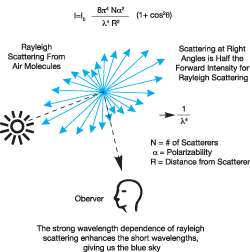
Rayleigh Scattering - Rayleigh Scattering refers to the scattering of light from the molecules in the air, and can be extended to scattering from particles up to about a tenth of the wavelength of the light. It is Rayleigh scattering off the molecules of the air which gives us the blue sky. Named after Lord Rayleigh, who calculated the scattered intensity from dipole objects, much smaller than the wavelength, to be as shown in the diagram.
Rayleigh scattering can be considered to be elastic scattering since the photon energies of the scattered photons is not changed. Scattering in which the scattered photons have either a higher or lower photon energy is called Raman scattering. Usually this kind of scattering involves exciting some vibrational mode of the molecules, giving a lower scattered photon energy, or scattering off an excited vibrational state of a molecule which adds its vibrational energy to the incident photon.
Read (Pre-Amplifier) Noise - In CCD imaging technology, unwanted signal or disturbance that is generated by the on-chip output amplifier. The noise can be reduced to a few electrons by modifying operating conditions.
Read-Noise-Limited Operation - In CCD imaging technology, operating the detection system such that read noise exceeds photon (shot) noise. This is an undesirable condition in which the image data is limited by experimental restrictions or deficiencies in the camera design.
Readout - Readout is the process by which data are taken from the pixels of the CCD and stored in computer memory. The pixels, which are arranged in a single row, are read out individually in sequence.Readout involves amplifying the charge on each pixel into a voltage, performing an A/D conversion, and storing the data in computer memory.The time taken to perform this operation is known as the "read time".
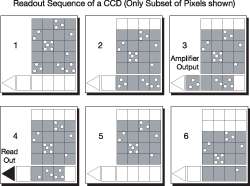
Readout Sequence of a CCD - In the course of readout, charge is moved vertically into the shift register, and then horizontally from the shift register into the output node of the amplifier. The readout sequence illustrated below (which corresponds to the default setting of the Full Resolution Image binning pattern) allows data to be recorded for each individual element on the CCD-chip.Other binning patterns are achieved by summing charge in the shift register and/or the output node prior to readout (see Horizontal and Vertical Binning).
1. Exposure to light causes a pattern of charge (an electronic image) to build up on the frame (or "image area") of the CCD-chip.
2. Charge in the frame is shifted vertically by one row, so that the bottom row of charge moves into the shift register.
3. Charge in the shift register is moved horizontally by one pixel, so that charge on the endmost pixel of the shift register is moved into the output node of the amplifier.
4. The charge in the output node of the amplifier is passed to the analog-to-digital converter and is read out.
5. Steps 3 and 4 are repeated until the shift register is emptied of charge.
6. The frame is shifted vertically again, so that the next row of charge moves down into the shift register.The process is repeated from Step 3 until the whole frame is read out.
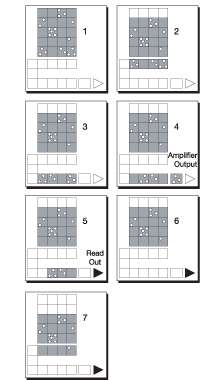
Readout Sequence of an EMCCD:-
1. Exposure to light causes a pattern of charge (an electronic image) to build up on the frame (or Image Area) of the EMCCD-chip.
2. Charge in the frame is shifted vertically by one row, so that the bottom row of charge moves into the shift register.
3. Charge in the shift register is moved horizontally by one pixel, so that charge on the endmost pixel of the shift register is moved into the Gain register.
4. Charge is shifted into the output node ofthe amplifier.
5. The charge in the output node of the amplifier is passed to the analog-to-digital converter and is read out.Steps 3 and 4 are repeated until the shift register is emptied of charge.
The frame is shifted vertically again, so that the next row of charge moves down into the shift register.The process is repeated from Step 3 until the whole frame is read out.In the course of readout, charge is moved vertically into the shift register, and then horizontally from the shift register into the output node of the amplifier. The simple readout sequence illustrated in the figure above (which corresponds to the default setting of the Full Resolution Image binning pattern) allows data to be recorded for each individual element on the CCD-chip.Other binning patterns are achieved by summing charge in the shift register and/or the output node prior to readout (see Binning).
Recirculation - A refrigeration process in which water forced-air is cooled then pumped back around a circuit. Used extensively in research & test laboratories.
Region Definition - The designation of a rectangular / square area on a CCD to be exposed as an image. The user defines the region by specifying coordinates in the serial, parallel (s, p) coordinate system.
Region of Interest (ROI) - Region of interest. A user-defined, rectangular area (a square is common) on a CCD that is exposed and processed as an image.
Resolution - A measure of how fine a detail can be detected, in terms of either space (spatial resolution), time (temporal resolution), or intensity.
Saturation - Saturation is the largest signal the CCD can measure. A signal is measured in terms of the amount of charge that has built up in the individual pixels on the CCD-chip. A number of factors determine the maximum amount of charge that the CCD can handle.
Scanning - The CCD is continually being "scanned" to prevent its becoming saturated with dark current (see dark signal). If the Scan is being used simply to "clean" the CCD (i.e. it is a Keep-Clean scan), the charge from the CCD is discarded.In an acquired scan, however, the charge undergoes A/D conversion and is acquired into computer memory so that it can be used for subsequent processing and display, i.e. it is readout (see section on Readout).
Scientific-Grade CCD - A high-performance CCD that offers fewer defects than commercial-grade CCDs. Scientific-grade CCDs produce better spatial resolution, have lower noise, and enable the user to accurately measure intensity differences between objects.
SDK - The AndorMCD Software Development Kit (SDK) gives the programmer access to the Andor range of CCD cameras and ICCD camera series. The key element of SDK is the 32-bit dynamic link library "ATMCD32D.DLL" which can be used with a wide variety of programming environments including C, C++, Visual Basic and LabVIEW.
Serial (Horizontal) Binning - The accumulation of charge from two or more pixels of a CCD's serial register into the output node before the charge is shifted for CCD readout.
Serial Binning Factor - In the serial register of a CCD, the number of pixels (in the serial direction) to be shifted to the output node, read out, and processed into an image. The binning factor is specified by the user in the imaging software prior to exposure of the CCD.
Serial Direction - In a serial, parallel (s, p) coordinate system, the direction beginning from the origin and moving away from it in a direction parallel to the serial register.
Serial Offset - When defining an ROI in the parallel register of a CCD, the distance (in pixels) between the parallel axis and the user-defined, rectangular / square exposure area on the CCD.
Serial, Parallel (S, P) Coordinate System - In CCD imaging technology, a nomenclature based on the point of orientation located on the parallel register in the corner closest to the output node. Coordinates increase as the locations move away from this origin. s represents the serial coordinate, p represents the parallel coordinate.
Serial (Horizontal) Register - A row of pixels adjacent to the parallel register. When the CCD is exposed to light, the serial register receives charge from the parallel register and shifts it to the output node to form an image.
Serial Shift - In a CCD, the movement of charge (accumulated from the parallel register) to the output node. The charge moves pixel by pixel along the serial register. From the output node, the charge is processed as an image.
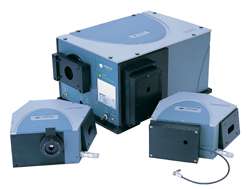
Serial Size - In CCD imaging technology, the size of the ROI (in pixels) extending in the serial direction.
Shamrock - Shamrock is the name of Andor's range of Czerny-Turner spectrographs which are available in 3 models, i.e.:
Shamrock SR-303i
Shamrock SR-163/SR-163i
For full specifications of the Shamrock range of spectrographs, please refer to the Products section.
Shift Register - The Shift Register usually consists of a single row of elements (or pixels) running parallel to and below the bottom row of light-gathering pixels (the image area) on the CCD-chip.The shift register is protected from light by an aluminum mask.The elements in the shift register have a greater capacity to store charge (a greater "well depth") than the other pixels on the CCD-chip.
Shot (Photon) Noise - Shot Noise is due to basic physical laws and cannot be removed. Any signal, whether it be a dark signal or a light signal, will have shot noise associated with it. It can be most simply defined as follows:
If the signal or dark signal = N electrons, the shot noise is the square root of N. You can do nothing about the shot noise of your signal, but by choosing minimum exposures and operating the CCD at suitably low temperatures, the dark signal, and hence the noise from the dark signal, can be reduced.
Signal-to-Noise Ratio (SNR) - The Signal to Noise Ratio (S/N) is the ratio between a given signal and the noise associated with that signal.Noise has a fixed component and a variable component (shot noise) which is the square root of the signal. Thus, the Signal to Noise Ratio usually increases (improves) as the signal increases.The maximum Signal to Noise Ratio is the ratio between the maximum signal (i.e. the saturation level) and the noise associated with that signal. At near saturation levels the dominant source of noise is the shot noise of the signal.
Silicon - A tetravalent, nonmetallic element used to fabricate CCDs.
Slow-Scan CCD - A CCD with special circuits that allow data readout at slower-than-standard rates in order to reduce read noise.
Spectrometer - An optical instrument that allows a user to view, record, and analyze a spectrum by rendering its component waves distinct and visible.
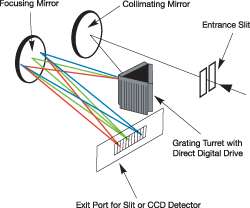
Spectrograph - An optical instrument that uses dispersed light from a source to produce a spectra. The elements that make up a spectrograph and their functions are as follows:
Entrance aperture: Provides source to be imaged at exit plane
Collimating optics: Produces collimated beam of light to dispersive element
Grating: Grating or prism disperses light from source into its component wavelengths
Focusing Optics: Focus light to imaging plane
Exit plane: Where the detector sits
Spectroscopy - The branch of science that deals with the theory and interpretation of spectra. Spectra are regions of the electromagnetic spectrum.
Storage Array - In a frame-transfer CCD or interline-transfer CCD, the portion of the parallel register that is covered with an opaque mask to provide temporary storage for collected charge.
Superpixels - A combination of vertical binning and horizontal binning. Horizontal binning involves shifting charge horizontally from several pixels at a time.Superpixels consist of two or more individual pixels that are binned and read out as one large pixel, i.e. the CCD effectively becomes a matrix of superpixels.
Subarray Readout - In a CCD, the process of moving charge from a user-defined, rectangular / square subregion of the array to an output amplifier for conversion to an image.
System Noise - In a CCD camera system, internally generated interference or a number of other factors can cause unwanted signal to appear in an image. Many noise sources exist, but three sources account for the majority of total system noise: dark noise, photon (shot) noise, and read noise.
Temporal Resolution - Temporal resolution is defined as the frequency at which images are recorded/captured in a specific place on the earth. The more frequently images are captured, the better the temporal resolution.
Time-Delay Integration (TDI) - An integration and CCD readout mode that allows the acquisition of long swaths of a moving image.
Thermoelectric Cooling - The process of pulling heat away from a CCD by using Peltier cooling devices.
Thinning - A process that uses acid etching to uniformly reduce the size of a CCD to approximately 10 µm so that an image can be focused on the back of the parallel register (where there is no gate structure).
Trigger - A signal (typically a TTL signal) that is transmitted in order to synchronize two or more instruments; something that acts like a mechanical initiator in setting up a process or reaction.
USB - Acronym for Universal Serial Bus, a standard computer interconnection system that was introduced in 1995 by Intel, Compaq, Microsoft and several other IT computer companies.
Ultraviolet (UV) - The region of the spectrum from about 400 nm (just beyond the violet in the visible spectrum) to about 40 angstroms (on the border of the x-ray region).
X-rays - X-rays are a form of electromagnetic radiation with a wavelength in the range of 10nm - 100pm (corresponding to frequencies in the range 30 PHz to 60 EHz).They were first discovered by accident in 1895 by a German scientist, Wilhelm Conrad Röntgen, who noticed them when experimenting with vacuum tubes and they aresometimes still called Röntgenstrahlen (Röntgen Rays) in German-speaking countries.Andor Technology manufactures a comprehensive range of CCD detection systems for a wide variety of X-ray applications.
